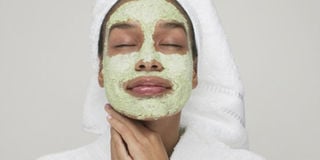Acne doesn’t have to ruin your life

Facial treatments have been found helpful in eliminating acne.
What you need to know:
Acne is sometimes seen as a problem that plagues teenagers but adults too can get it. It is important to know what triggers it to see how to fight it.
Acne can be treated. This skin problem, which starts when oil and dead skin cells clog up your pores appears in both men and women. Seasonal acne can go away on its own but in some people, acne that is hormone-related tends to become a chronic problem. You do not have to let acne define who you are because dermatologists can treat this skin problem.
Acne usually develops in the teen and young adult years of development. During this time, both males and females usually produce more testosterone than at any other time in life. This hormone causes oil glands to produce more oil called sebum. The extra oil can clog pores thereby causing acne.
Dr Pius Mwanja, a general practitioner at Life Link Medical Centre, says different people have different reactions about puberty and hormonal changes and this explains why some people have acne while others do not.
What happens?
Acne typically appears on your face, neck, chest, back and shoulders because these areas of the skin have majority of the oil (sebaceous) glands. Acne occurs when hair follicles become plugged with oil and dead skin cells. As a result, bacteria can grow in this mix which causes swelling, redness, and pus (pimples).
Malik Ssempereza, a dermatologist at Unity Skin Clinic, says, “Hair follicles are connected to oil glands. These glands secrete an oily substance (sebum) to lubricate your hair and skin. Sebum normally travels along the hair shafts and through the openings of the hair follicles onto the surface of your skin.”
When the body produces excess sebum and dead skin cells, the two can build up in the hair follicles. They form a soft plug, creating an environment where bacteria can thrive. If the clogged pore becomes infected with bacteria, inflammation results.
Ssempereza remarks, “The plugged pore may cause the follicle wall to bulge and produce a whitehead. Or the plug may be open to the surface and may darken, causing a blackhead. A blackhead may look like dirt stuck in pores but in fact the pore is instead congested with bacteria and oil.”
Pimples are raised red spots with a white centre that develop when blocked hair follicles become inflamed or infected. Blockages and inflammation that develop deep inside hair follicles produce cyst-like lumps below the surface of your skin.
Sometimes there are more serious lesions that appear red and swollen due to inflammation or infection of the tissue around the clogged follicles, which are often painful and feel hard. They are referred to as papules.
Although acne is not a serious health risk, severe acne can cause permanent scars and can damage a person’s esteem. Dr Mwanja says, “Acne usually gets better on its own in the adult years when your body produces less testosterone. During the early 20s, acne must clear (on its own) but if it does not, it is important to see a dermatologist.”
Triggers of acne
The major cause of acne is usually oils clogging the pores of the skin due to hormonal imbalances. Still, some women have pre-menstrual acne flare-ups until adulthood due to changing hormone levels. Such adolescent girls and adult women get the acne two to seven days before the start of the menstrual periods.
Hormonal changes related to pregnancy and the use of some medications also can affect sebum production thereby causing acne.
Some people are genetically prone to acne as genetics may also matter. If your parents had acne, you may inherit the condition.
People with acne prone skin are more likely to react to make-up creams and lotions that are oily or those that contain steroids. Stress can make acne worse. The cells which produce sebum contain receptors for stress hormones which literally increase the formation of the oils.




